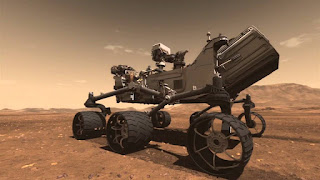LIFE ON THE RED PLANET
LIFE ON THE RED PLANET
( Written in 2012 in the context of the landing of NASA’s Curiosity rover on Mars)
Nikunja Bihari Sahu
Scientists have long speculated about the possibility of life on Mars owing to its striking similarity to our Earth. Fictional Martians have been a recurring feature of popular entertainment shows of the 20th and 21st centuries, but it remains an open question whether life currently exists on Mars, or has existed there in the past. The recent findings of the NASA rover Curiosity have taken us one step closer to answering this ever-elusive question.
Our craze for Mars was probably first aroused in the year 1866 when an Italian astronomer Giovanni Schiaparelli observed certain criss-crossed lines on Mars with his telescope. These were, however, later found to be sheer optical illusions. An American astronomer Perceval Lowell built an observatory exclusively dedicated to the study of Mars. He described these lines as irrigation channels dug by a highly intelligent Martian civilization to bring water from its polar ice caps to their crop fields in the equatorial deserts. In 1899, the famous science fiction writer H. G. Wells wrote a novel entitled ‘War of the Worlds’ narrating a horror invasion of the Earth by the Martians. This was later broadcast as a radio play that created a wave of horror and panic among the people. Since then, the red planet has remained a source of mystery for mankind regarding the existence of water and life.
Spectroscopic analysis of the atmosphere of Mars began in the year 1894 when the U.S. astronomer William Wallace Campbell showed that neither water nor oxygen was present in the Martian atmosphere. By 1909, better telescopes and the best perihelion opposition view of Mars since 1877 conclusively put an end to the canal theory.
Mariner- 4 probes performed the first successful flyby of the red planet, returning the first pictures of the Martian surface in 1965. The photographs revealed that its arid surface was covered with craters, indicating a lack of plate tectonics and weathering of any kind for the last 4 billion years. The probe also found that Mars has no global magnetic field that would protect the planet from potentially life-threatening cosmic rays. The probe was able to calculate the atmospheric pressure on the planet which was estimated to be about 0.6 kPa (compared to Earth's 101.3 kPa), meaning that liquid water could not exist on the planet's surface. After these findings of Mariner-4, the search for life on Mars was only restricted to a search for less developed microorganisms like bacteria as the Martian environment is too harsh to support any multi-cellular organism
Subsequently, NASA sent two successive probes named ‘Viking-1’ and ‘Viking-2’ in 1976 in its quest for direct evidence of life on the planet. These probes actually landed on the planet and looked around for the possible existence of life. However, the onboard cameras did not find any sign of living creatures moving around. Their spectacular photographs showed a bizarre Martian landscape filled with miles of red soil strewn with rocks and interspersed with dry river beds and dusty barren valleys. The sky also looked pink because of the effect of the scattering of atmospheric particles. The robotic arms of the lander scooped lumps of the soil and subjected it to rigorous examination in its onboard lab for any possible existence of microbial life. But the result was negative!
Mars Pathfinder, another spacecraft sent by NASA, landed on the red planet on 4th July 1997. A rover named ‘Sojourner’ rolled out of the spacecraft to the surface of the planet. From its landing until the final data transmission on 27th September 1997 the mission returned as many as 17,000 photographs and more than 15 chemical analyses of rocks and soil, and extensive data on winds and other weather factors. This was followed by NASA’s two more Mars Exploration Rovers named ‘Spirit’ and ‘Opportunity’ in 2004 for geological examination of the rocks for any evidence of water in past.
In a recent development, the US Space Agency NASA took us one step closer to answering this fundamental question of whether life ever existed on Mars. NASA, based on an analysis of a rock sample collected by the rover Curiosity, officially announced on March 12 that ancient Mars could have supported a habitable environment offering a cradle for micro-organisms to survive.
Curiosity sent on a two-year mission to hunt for the possibility of microbial life, landed on the red planet on August 6, 2012, inside the Gale crater. On February 8, 2013, the geologist robotic arm of the rover bored a 2.5 ‘ deep hole into a sedimentary rock outcrop named ‘John Klein’ lying in an ancient stream bed of the Gale Crater using its arm-mounted hammering drill and collected some finely grained gray powder sample. On subsequent analysis of the sample by the two onboard instruments named Chemistry and Mineralogy (CheMin) and Sample Analysis at Mars (SAM), signatures of a wide range of key chemical ingredients essential for life including Sulfur, Nitrogen, Hydrogen, Oxygen, Phosphorus and Carbon were identified. This suggested a possible chemical energy source for life to thrive on the planet in the distant past. The analysis also showed the presence of clay minerals in a non-saline environment that points to the existence of a watery past like a lake abounding with plenty of fresh water. Although the exact period when this water flowed is unknown, it is estimated to be at least 3 billion years old.
Curiosity still hasn't found any complex organic compounds like amino acids, the building blocks of proteins necessary for triggering life. This may seem obvious as such big molecules tend to be degraded over time, making their detection a challenge, even on Earth. However, the researchers believe that although complex organics were absent at the John Klein site, the site could still have supported life as Carbon, in its inorganic form, is used by many microbes on Earth to generate the organics they incorporate into their cellular machinery. The rover team is optimistic about searching for relatively safer spots on the planet that could offer protection against Mars' relatively high levels of radiation from its Ozone-less sky for these pristine organics to be preserved for billions of years. In this mission, the rover will come out of the Gale crater in the days to come to explore the other areas of the planet potential candidates for life.
Mars is our nearest celestial neighbor next to Venus. Orbiting at a distance of nearly 230 million kilometers away from the Sun, it is almost half of the Earth’s size. It is in many respects similar to our own planet Earth. It has a thin atmosphere which, like the Earth, is a soup of various gases. There are also changes in day and night and seasonal cycles on the planet. While each Martian day is nearly 24 hours long (equal to an Earth day), the Martian year is almost twice as long as on the Earth. It has also huge ice caps at the Poles where a lot of frozen water is supposed to be trapped. Due to all these similarities, man has long cherished colonizing the planet. However, there seems to have no sign of life on Mars at present. The planet has no Ozone layer. Had there been any life-form on the planet, it would have been of very rudimentary type and thriving only within the cracks and crevices of rocks or underground locations for protection against the hazardous ultraviolet radiations of the Sun. However, the planet’s relatively close proximity to the Earth and moderate climatic conditions than any other planet hold a lot of promise for man to plan for a future settlement.
It is shocking to find that due to man-made pollution and the consequent natural degradation in recent days, our planet Earth has lost its glory and is on the brink of a catastrophe. Added to this, other factors like the population explosion and scarcity of food and resources have also put tremendous strain on the basic life support system of the planet. Life on the planet is therefore severely threatened now like never before. This has compelled man to look beyond the Earth in the vast wilderness of space for a possible abode in case of a fallout. Probably, the red planet Mars holds the promise for such a future destination in our quest for a new home. Days are not very far when regular shuttle flights will ferry groups of men and women to the planet which they will adopt as their sweet homes. However, only time will tell when exactly this dream would come true!
Education Officer
Regional Science Centre
Pt. Jawaharlal Nehru Marg
Bhubaneswar-751013
Phone: 9777220697 / 9938974485




Comments
Post a Comment